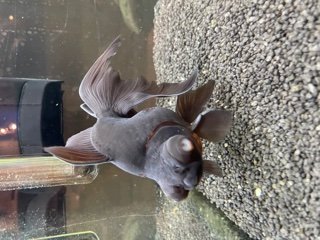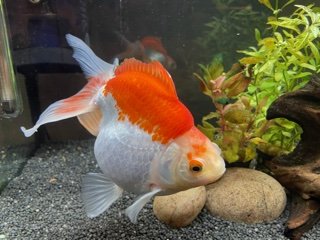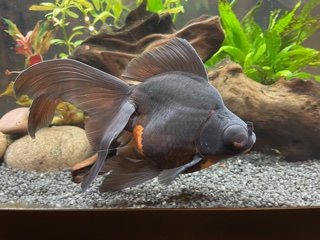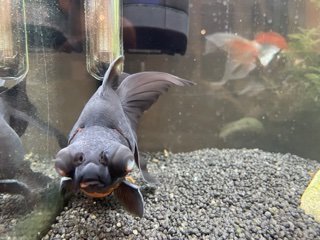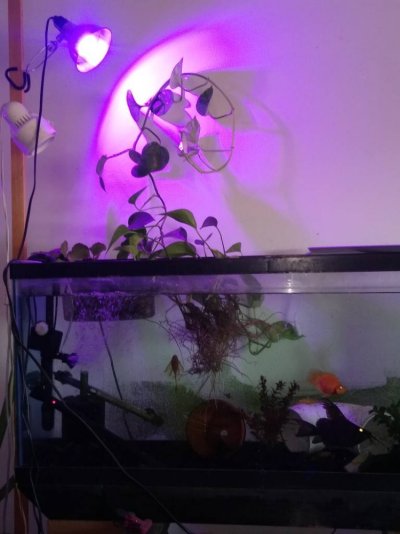Hairboy
Aquarium Advice Newbie
Nitrate at 120ppm. Please help...
Hello Everyone.
My name is Matt, and I've been keeping Fancy goldfish for a mere 5 years now. I tend to be fairly thorough in researching things, and up until now I felt like I was doing a good job when it came to looking after my two fancy goldfish - Gloria (5 year old Fantail) and Dudley (2 year old Black Moor). It appears that I was wrong...
I moved house a year ago, and since then, the fish haven't thrived. I would greatly appreciate any advice you can give me, as I've tried lots of different methods to help their symptoms, but to no avail. Please allow me to elaborate...
I have a 125L (27.5 gallon) Fluval Roma tank, with a Fluval U3 filter and a Eheim thermocontrol heater to bring the tank to 23 centigrade because I'm in the UK in a flat with no double glazing, and it gets freezing in the winter! As I said, I have a 5 year old fantail and a 2 year old black moor. They behave fine most of the time, but recently they appear a bit sluggish. Skulking in corners. The black moor has also developed one very cloudy eye, perhaps slightly enlarged. Originally I thought it was because he might have injured it on a spiky fake plant, so I removed all fake plants and put real ones in. I also used aquarium salt and Melaflix at different points in case it was an infection. Nothing has cleared it up. His other eye is OK, perhaps slightly cloud, and with a small red lump in it.
I have done water test, and it appears the nitrates are very high. I don't know if this could be the cause of their issues. Here are the readings of the tank:
pH: 7.6
Ammonia: 0.25ppm
Nitrite: 0
Nitrate: 120ppm
This is the analysis of the tap water used to fill the tank:
pH: 7.6
Ammonia: 0.25ppm
Nitrite: 0
Nitrate: 20ppm
Obviously the nitrate is way too high. A couple of weeks ago I started using a bag of Seachem Purigen in place of one of the carbon filters in the Fluval U3 filter, I also added Seachem Matrix. No sign that this has had any positive effect on the nitrate levels yet.
My cleaning regime is using a vacuum once a week to remove 25% of the water. The tank is planted with 5 real plants and the substrate is an inch /3cm deep fine black aquarium gravel.
As for feeding... I feed them 4 pinches of Tetra Goldfish Gold Japan pellets for fancy goldfish, once a day in the evening. I also give them a few peas once a week.
Any help would be gratefully received. I hate seeing them so glum, and really want to sort Dudley's eye out. Please check out attached images.
Thanks so much for taking the time.
All the best,
Matt.
Hello Everyone.
My name is Matt, and I've been keeping Fancy goldfish for a mere 5 years now. I tend to be fairly thorough in researching things, and up until now I felt like I was doing a good job when it came to looking after my two fancy goldfish - Gloria (5 year old Fantail) and Dudley (2 year old Black Moor). It appears that I was wrong...
I moved house a year ago, and since then, the fish haven't thrived. I would greatly appreciate any advice you can give me, as I've tried lots of different methods to help their symptoms, but to no avail. Please allow me to elaborate...
I have a 125L (27.5 gallon) Fluval Roma tank, with a Fluval U3 filter and a Eheim thermocontrol heater to bring the tank to 23 centigrade because I'm in the UK in a flat with no double glazing, and it gets freezing in the winter! As I said, I have a 5 year old fantail and a 2 year old black moor. They behave fine most of the time, but recently they appear a bit sluggish. Skulking in corners. The black moor has also developed one very cloudy eye, perhaps slightly enlarged. Originally I thought it was because he might have injured it on a spiky fake plant, so I removed all fake plants and put real ones in. I also used aquarium salt and Melaflix at different points in case it was an infection. Nothing has cleared it up. His other eye is OK, perhaps slightly cloud, and with a small red lump in it.
I have done water test, and it appears the nitrates are very high. I don't know if this could be the cause of their issues. Here are the readings of the tank:
pH: 7.6
Ammonia: 0.25ppm
Nitrite: 0
Nitrate: 120ppm
This is the analysis of the tap water used to fill the tank:
pH: 7.6
Ammonia: 0.25ppm
Nitrite: 0
Nitrate: 20ppm
Obviously the nitrate is way too high. A couple of weeks ago I started using a bag of Seachem Purigen in place of one of the carbon filters in the Fluval U3 filter, I also added Seachem Matrix. No sign that this has had any positive effect on the nitrate levels yet.
My cleaning regime is using a vacuum once a week to remove 25% of the water. The tank is planted with 5 real plants and the substrate is an inch /3cm deep fine black aquarium gravel.
As for feeding... I feed them 4 pinches of Tetra Goldfish Gold Japan pellets for fancy goldfish, once a day in the evening. I also give them a few peas once a week.
Any help would be gratefully received. I hate seeing them so glum, and really want to sort Dudley's eye out. Please check out attached images.
Thanks so much for taking the time.
All the best,
Matt.
Attachments
Last edited:

